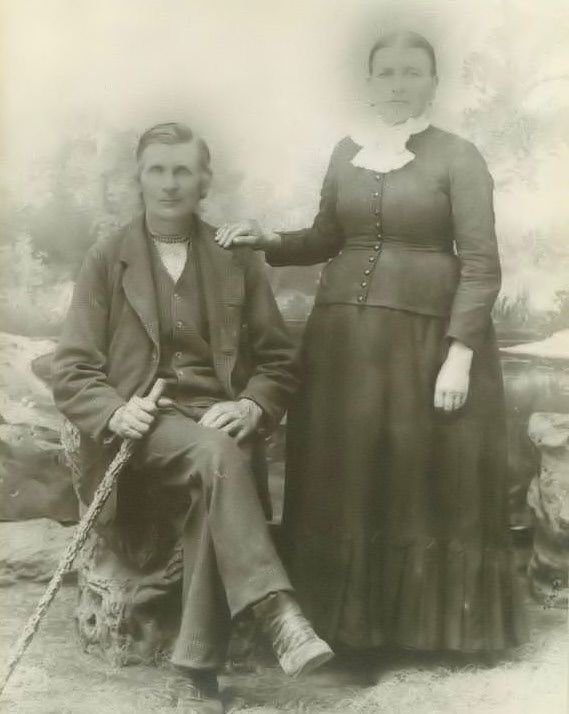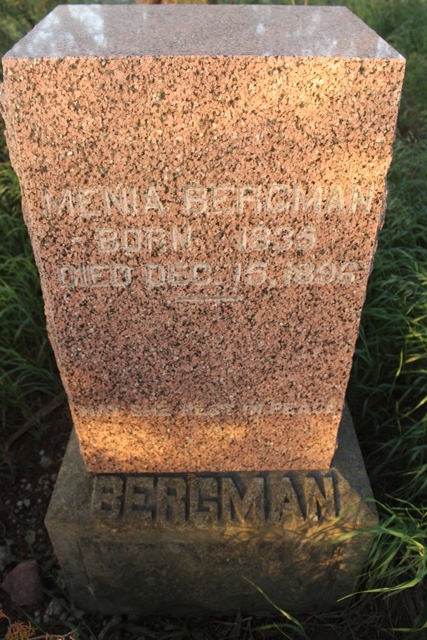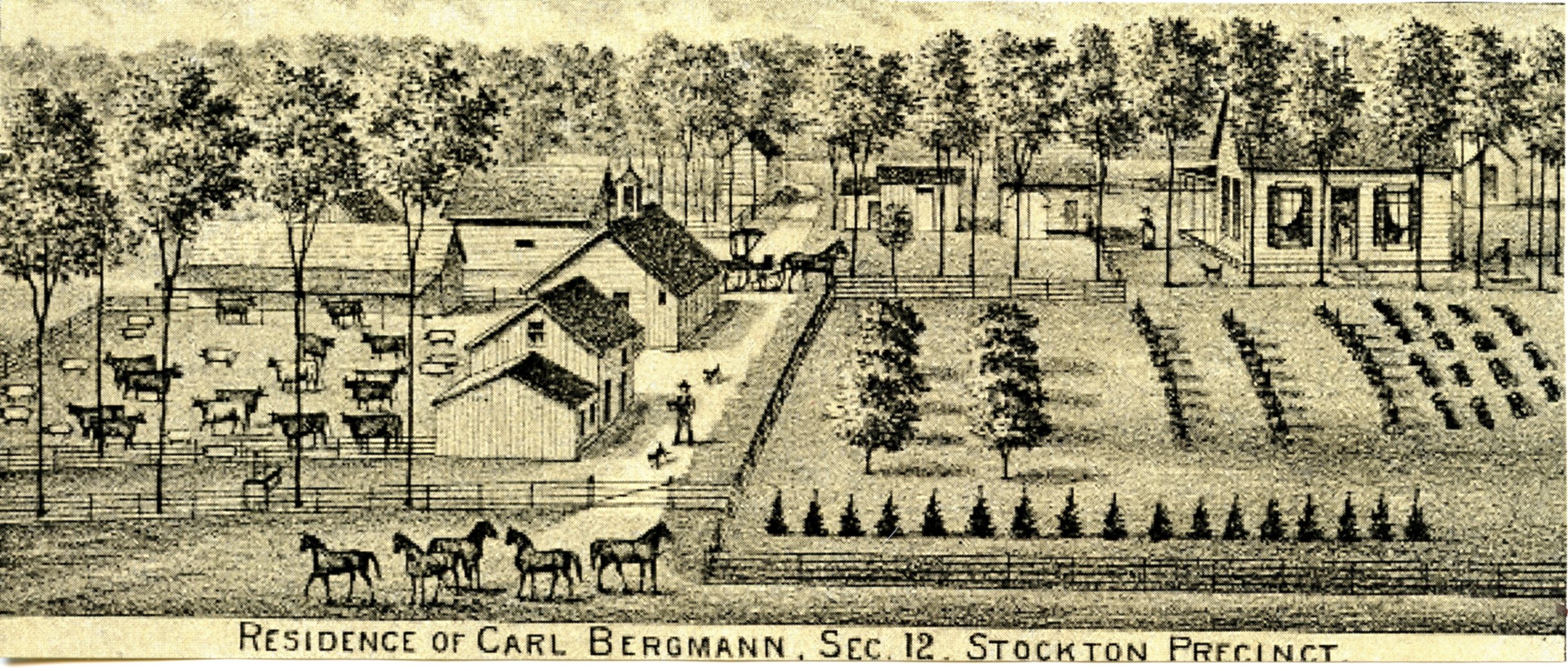"Mother"
only 2 headstones remain in this cemetery.
Information by Dolores Hahn 47046254.
A special thank you to Dolores for transferring Carl and Menia to our care.
Wilhelmina Sangbusch was the daughter of Jon and Dora Sangbusch. She married Carl Bergman in Prussia on November 11, 1862. He was the son of Johann/Joachim Bergman.
To this union eleven children were born. With only six living to adulthood they were William, Otto, Anna, Wilhelmina, Amanda and August.
Arrival date March 31, 1868 in New York, from the Port of Departure Hamburg.
Census 1880 Stockton, Lancaster County, Nebraska.
Census 1885 Stockton, Lancaster County, Nebraska.
Census 1900 Stockton, Lancaster County, Nebraska.
Buried on their homestead located in Section 12, Stockton Precinct. To see a picture of their homestead see photo #5.
Information from census, family Bible and obituary.
Framed drawings of Carl and Menia Bergman courtesy of Gary C. Bergman their great grandson and grandson of August Bergman.
Photograph of Carl and Menia Bergman from the photograph album of their daughter Anna (Bergman) Jensen.
Written by Dori 47796684.
The Bergman Story written by Rudolph Umland, "They Broke the Sods" book.
My people were peasant folk who came to America in the middle of the nineteenth century and settled on the prairies of the Middle West. Carl Bergmann, my maternal grandfather, was born in Prussia, May 11, 1835. In November, 1862, when he was twenty-seven years old, he married Wilhelmina Sangbusch, daughter of Jon and Dora Sangbusch. Wilhelmina was born December 10, 1836, and, before her marriage, had worked as a maid for rich families in her native province.
During the first few years following their marriage, Carl and Wilhelmina Bergmann managed to save enough money for passage to America. In the early part of 1868 they left their native land, accompanied by three children and Carl's father Johann. They landed at New York city, they were met by Charles Retzlaff, a German from their native province, who took them to his farm on Stevens Creek in Lancaster County, Nebraska.
Nebraska had been created a State only the year before.
There was a newness about the land, most of which was virgin prairie untouched by plow. For two years the Bergmann's lived in Charles Retzlaff's barn, Carl working as a farm laborer and carefully hoarding his earnings for the purchase of a yoke of oxen, a pig, a wagon, a plow; then the family moved to a 160-acre homestead near by.
During their first years in Nebraska, the Bergmann's occasionally drove to Nebraska City, Otto County, Nebraska forty miles distant, to market their produce and do their trading. Sometimes Carl Bergmann walked the distance, a bag of meal on his back. Nebraska City was then a flourishing river town, its streets full of immigrants, freighters, ox-teams, mule-teams and covered wagons. The city had grown prosperous in preceding years from the great overland
freighting business. Stagecoaches operated at the time between Nebraska City and Lincoln, which was town of only five hundred inhabitants. It was not until after 1870, when the first railroad reached Lincoln, that town developed as a trace center. Before that settlers went to Lincoln chiefly to obtain salt, large deposits of which lay glistening on the flats west of town.
Carl Bergmann's homestead was on a branch of Nemaha Creek in Stockton Precinct. Hungry Oto Indians often stopped at the house to beg for food. The early seventies were hard years for the Bergmann's. Grasshoppers, which came
in great swarms, destroyed their crops.
Two of their children died of scarlet fever; another died of a skin infection. Of the eleven children born to the
Bergmann's, only six-William, Otto, Anna, Minnie, Amanda and August-lived to reach maturity.
Two of their first children had been left in graves in the Old Country. During the successive years of grasshopper plague, many of the settlers pulled up stakes and quit the country, but the Bergman's remained. The most severe visitation of the 'hoppers occurred in 1874. Wilhelmina
Bergman spread quilts over the cabbages in her garden only to have them eaten through by the ravenous insects. Even as the discouraged families were moving away, however, the railroads were bringing new settlers to Nebraska.
On December 15, 1896, Minnie Umland's mother died. A typical German peasant woman, Wilhelmina Bergman had worked hard all her life; she was inured to privations.
When she was a young girl in Prussia her mother had told her stories about the great reformist Martin Luther and these stories she had remembered and told her own
children in the New World. The coffin containing her remains was placed in a lumber-wagon and carried to the top of a pasture hill on the Bergman homestead.
There, beside the graves of the three Bergman children and Carl's father, it was deposited in the frozen earth. Minnie Umland, twenty at the time, had shortly before been delivered of her third baby. The thought of her mother in the lonely grave on the pasture hill was to haunt her the rest of her life. When her father, Carl Bergman, died April 1, 1906, the sixth and last mound was added to the little group of graves on the hill. A board fence was put around the graves to keep off the cattle, and a
few evergreen trees were planted.
"Mother"
only 2 headstones remain in this cemetery.
Information by Dolores Hahn 47046254.
A special thank you to Dolores for transferring Carl and Menia to our care.
Wilhelmina Sangbusch was the daughter of Jon and Dora Sangbusch. She married Carl Bergman in Prussia on November 11, 1862. He was the son of Johann/Joachim Bergman.
To this union eleven children were born. With only six living to adulthood they were William, Otto, Anna, Wilhelmina, Amanda and August.
Arrival date March 31, 1868 in New York, from the Port of Departure Hamburg.
Census 1880 Stockton, Lancaster County, Nebraska.
Census 1885 Stockton, Lancaster County, Nebraska.
Census 1900 Stockton, Lancaster County, Nebraska.
Buried on their homestead located in Section 12, Stockton Precinct. To see a picture of their homestead see photo #5.
Information from census, family Bible and obituary.
Framed drawings of Carl and Menia Bergman courtesy of Gary C. Bergman their great grandson and grandson of August Bergman.
Photograph of Carl and Menia Bergman from the photograph album of their daughter Anna (Bergman) Jensen.
Written by Dori 47796684.
The Bergman Story written by Rudolph Umland, "They Broke the Sods" book.
My people were peasant folk who came to America in the middle of the nineteenth century and settled on the prairies of the Middle West. Carl Bergmann, my maternal grandfather, was born in Prussia, May 11, 1835. In November, 1862, when he was twenty-seven years old, he married Wilhelmina Sangbusch, daughter of Jon and Dora Sangbusch. Wilhelmina was born December 10, 1836, and, before her marriage, had worked as a maid for rich families in her native province.
During the first few years following their marriage, Carl and Wilhelmina Bergmann managed to save enough money for passage to America. In the early part of 1868 they left their native land, accompanied by three children and Carl's father Johann. They landed at New York city, they were met by Charles Retzlaff, a German from their native province, who took them to his farm on Stevens Creek in Lancaster County, Nebraska.
Nebraska had been created a State only the year before.
There was a newness about the land, most of which was virgin prairie untouched by plow. For two years the Bergmann's lived in Charles Retzlaff's barn, Carl working as a farm laborer and carefully hoarding his earnings for the purchase of a yoke of oxen, a pig, a wagon, a plow; then the family moved to a 160-acre homestead near by.
During their first years in Nebraska, the Bergmann's occasionally drove to Nebraska City, Otto County, Nebraska forty miles distant, to market their produce and do their trading. Sometimes Carl Bergmann walked the distance, a bag of meal on his back. Nebraska City was then a flourishing river town, its streets full of immigrants, freighters, ox-teams, mule-teams and covered wagons. The city had grown prosperous in preceding years from the great overland
freighting business. Stagecoaches operated at the time between Nebraska City and Lincoln, which was town of only five hundred inhabitants. It was not until after 1870, when the first railroad reached Lincoln, that town developed as a trace center. Before that settlers went to Lincoln chiefly to obtain salt, large deposits of which lay glistening on the flats west of town.
Carl Bergmann's homestead was on a branch of Nemaha Creek in Stockton Precinct. Hungry Oto Indians often stopped at the house to beg for food. The early seventies were hard years for the Bergmann's. Grasshoppers, which came
in great swarms, destroyed their crops.
Two of their children died of scarlet fever; another died of a skin infection. Of the eleven children born to the
Bergmann's, only six-William, Otto, Anna, Minnie, Amanda and August-lived to reach maturity.
Two of their first children had been left in graves in the Old Country. During the successive years of grasshopper plague, many of the settlers pulled up stakes and quit the country, but the Bergman's remained. The most severe visitation of the 'hoppers occurred in 1874. Wilhelmina
Bergman spread quilts over the cabbages in her garden only to have them eaten through by the ravenous insects. Even as the discouraged families were moving away, however, the railroads were bringing new settlers to Nebraska.
On December 15, 1896, Minnie Umland's mother died. A typical German peasant woman, Wilhelmina Bergman had worked hard all her life; she was inured to privations.
When she was a young girl in Prussia her mother had told her stories about the great reformist Martin Luther and these stories she had remembered and told her own
children in the New World. The coffin containing her remains was placed in a lumber-wagon and carried to the top of a pasture hill on the Bergman homestead.
There, beside the graves of the three Bergman children and Carl's father, it was deposited in the frozen earth. Minnie Umland, twenty at the time, had shortly before been delivered of her third baby. The thought of her mother in the lonely grave on the pasture hill was to haunt her the rest of her life. When her father, Carl Bergman, died April 1, 1906, the sixth and last mound was added to the little group of graves on the hill. A board fence was put around the graves to keep off the cattle, and a
few evergreen trees were planted.












